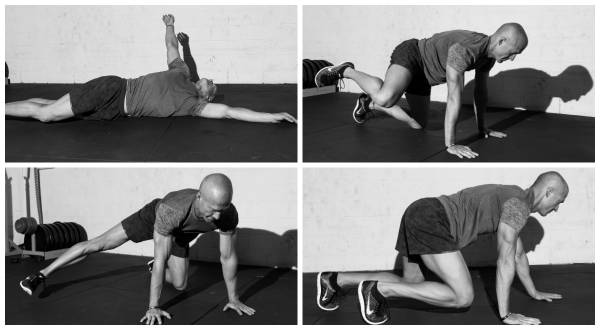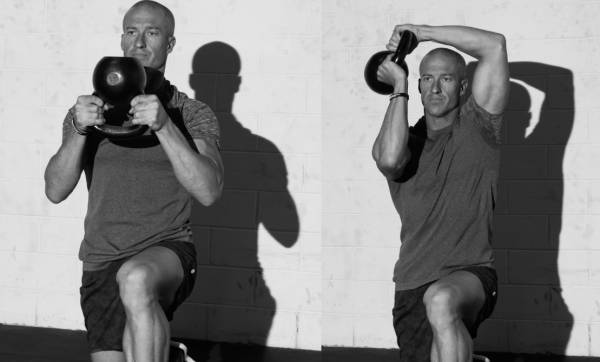Getting older sucks for athletes. Sure, there are those who say they’re in the best shape of their lives in their forties and fifties, but they are a minority (and obviously weren’t great athletes when younger). The biggest problem with getting older and wanting to stay competitive is that you become more susceptible to injury.
Despite all the heavy abuse it’s taken in the gym and on the fields, I’ve never had any problems with my back. But at forty-plus, it has started to show the first signs of trouble down the road. Where once I could abuse it with heavy pack work, heavy lifting, and wrestling without concern, these days things are different. If you want to save yourself a lot of trouble down the road, then read on.
I’ve had a pretty clean slate when it comes to back problems, but age is changing that.
Pain Creates Fear of More Pain
Fear is the biggest hurdle facing people who are starting to deal with back problems. There’s an inbuilt button in our heads that immediately gets pressed whenever something starts to feel not quite right in our backs.
If your back got hurt, it got hurt for one of a few reasons:
- You weren’t strong enough.
- You didn’t have enough strength endurance to withstand what you were repeatedly doing.
- You lacked the flexibility to get into that position safely.
Once that fear button is pushed, it can be hard to convince the mind and the body that it is alright to start to do some serious work again. To convince the body that everything is alright, we need to take some threat out of training and revert back to easier work.
The Answer Is Not More Stretching
Most back problems are caused by an inability to deal with flexion, rotation, or both. Dr. Stuart McGill has said that in 80 percent of cases who present to his clinic for treatment, he can alleviate lower back pain by simply having them stop stretching the area. This directly contradicts the normal clinical advice given to someone with a lower back complaint.
In her book Diagnosis and Treatment of Movement Impairment Syndromes, Dr. Shirley Sahrmann says that:
…most spine dysfunctions occur because of excessive relative flexibility, particularly at specific segments, rather than at the segment of reduced flexibility.
In other words, your lower back shouldn’t be all bendy and whippy like a willow tree in a storm. This is why heading off to yoga to fix lower back problems is also fraught with danger. The area doesn’t need more stretching.
If it doesn’t need more stretching, what does it need?

Some of the drills I recommend: rolling, fire hydrants, and crawling.
Mobility and stability are a little bit like Schrodinger’s cat. They are both there and not there simultaneously, and in varying degrees, in the movement systems of the body. But we’ve already established that the lower back doesn’t need to move more and become more mobile. That means we must need more stability.
Gaining stability in the lower back isn’t a case of just going to the gym and doing some deadlifts or swings. It’s not that simple. Lower back stability is actually built on a foundation of adequate mobility in the joints above and below – the hips and thoracic spine. This can be done simultaneously by restoring correct trunk muscle function, so that normal movement can be regained quickly.
The cure for the lower back isn’t about addressing the spine itself, but regaining lost movement in the hips and T-spine, and restoring or improving core strength.
When it comes to building a solid foundation, we have three key positions. These foundational postures all should be worked before attempting to regain movement in our functional positions.
- Lying
- Quadruped (all fours)
- Kneeling
3 Key Foundational Postures
1. Start From the Ground
The best way to begin is in a stress-free environment, and that means we start from the ground. We’ll start with an exercise that works both hip mobility and core strength. This leg raise pattern is done with some core assistance, provided by a kettlebell being held at arms’ length.
While we’re down here, we may as well perform a stretch to open up the T-spine, so we’re going to superset the leg raises with a movement called a rib grab. Like the leg raises, the benefit of the rib grab is that it isn’t just a passive stretch. You have to work to achieve the new range you’re after, so you develop strength and increased movement at the same time.
To finish off, we’re going to do some upper body rolling. But before you can roll, you need to have developed adequate range in both the hips and T-spine. Don’t bring your mobility problems to a motor control exercise. You must fix the existing mobility problems before you can address the necessary stability requirements. If your hips are stuck, feel free to include lower body rolling too, but for most people you can just do the upper rolls shown in the video.
2. Quadruped Exercises
The next step could simply be the next exercise in your warm up sequence, or it might take you a few weeks to get to. It will be another combination of exercises, this time from the quadruped position. These two exercises are the fire hydrant series and the T-spine rotations in both internal and external rotation. We also need to do some core work while in this position, so you’ll finish each set with a few meters of crawling.
This is where things start to get tricky. It’s likely one of two things is happening for you now. Either your back feels fine at this point – whether it’s been a few sets or a few weeks – or it doesn’t. If you feel fine, then start back with normal loading slowly. Remember that for every week off you’ve had due to sickness or injury, it can take four weeks to recover that form.
3. Kneeling Exercises
If you’re still not ready to resume normal training (in standing postures), then this next bit is for you. The kneeling position is a transition between the ground-based postures and standing. This is why you should absolutely be training lunges, as they’re a key link in your ability to change levels athletically. The kneeling position is perhaps the most useful place to start to work again, as it is the first time the core is working properly in the same alignment it will be when standing. The only difference is that by the time you get here, mobility has been developed, so you need to start working on strengthening the weak lower back and the surrounding abdominal muscles.
The exercises you’ll use are the half-kneeling halo (pictured below) and the chop using a resistance band. Both require good stability at the hip (remember what I said about mobility and stability having to exist simultaneously) while addressing many other qualities. Think of these exercises as similar to the rolling that was performed early on. Any motor control issues will be highlighted if they still exist.

The kneeling position is perhaps the most useful place to start to work again.
Put It All Together
Once these are mastered you can return to standing postures. My warm up now consists of exactly this sequence:
- 1 set of 5 reps each: leg lowers/rib grabs/rolling
- 1 set of 5 reps each: fire hydrants/ T-spine rotations/crawling (10 meters)
- 1 set of 5 reps each: half-kneeling halos/chops
I finish each warm up with 3 sets of single leg deadlifts (SLDL) and get ups, performing 5 reps of SLDLs and a single get up each side. Each set is progressively heavier than the one before. By the time I have warmed up, my body is ready to go and my back, and the surrounding areas, is fired up and ready to work.
Take the Time to Really Heal
Healing of any kind takes time. Unless you’ve had a severe back injury, it should settle down within six weeks. My general rule of thumb is to start taking anti-inflammatories immediately to reduce the swelling. Healing will not begin until the inflammation is gone.
The next step is to avoid sitting as much as possible. I’m actually typing this from a standing work position to avoid sitting. Add in the mobility/stability supersets as often as you can. If possible, instead of doing them a few times once per day, do one of each multiple times per day.
And finally, be guided by pain. Let your body heal without trying to rush the process. Add load and intensity as you feel appropriate. And if the problem hasn’t resolved within that six-week time frame, you need to go see someone.
More Tips on Bulletproofing Your Back
- A Safe System for Heavy Lifting After a Disc Bulge
- The Way You Stand is Damaging Your Body
- Banish Pain Permanently: Basic Drills to Repair Your Posture
- New on Breaking Muscle Today
Photos courtesy of Andrew Read.






